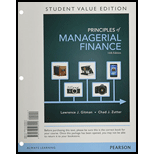
Principles of Managerial Finance, Student Value Edition Plus NEW MyLab Finance with Pearson eText -- Access Card Package (14th Edition)
14th Edition
ISBN: 9780133740912
Author: Lawrence J. Gitman, Chad J. Zutter
Publisher: PEARSON
expand_more
expand_more
format_list_bulleted
Question
Chapter 14, Problem 14.1WUE
Summary Introduction
To determine: The amount of cash required to pay the dividends.
Introduction:
Dividend is a sum of money paid to the shareholders of the company. It is distributed among the investors from the portion of company’s earnings. It is paid by the company to the shareholders either in the form of cash or stock.
Summary Introduction
To discuss: The time when the stock start to sell on ex-dividend.
Expert Solution & Answer
Want to see the full answer?
Check out a sample textbook solution
Students have asked these similar questions
Given the solution and financial accounting question
Reflection on how public budgets influence community outcomes (e.g., housing, education, public safety). Identify one real city, school district, or agency where budget decisions have created inequities or made a positive impact.
19. A company’s weighted average cost of capital (WACC) includes:A. Only equityB. Only debtC. Both equity and debtD. Only retained earnings
need help
Chapter 14 Solutions
Principles of Managerial Finance, Student Value Edition Plus NEW MyLab Finance with Pearson eText -- Access Card Package (14th Edition)
Ch. 14.1 - What two ways can firms distribute cash to...Ch. 14.1 - Why do rapidly growing firms generally pay no...Ch. 14.1 - The dividend payout ratio equals dividends paid...Ch. 14.2 - Prob. 1FOPCh. 14.2 - Prob. 14.4RQCh. 14.2 - Prob. 14.5RQCh. 14.2 - Prob. 14.6RQCh. 14.3 - Does following the residual theory of dividends...Ch. 14.3 - Contrast the basic arguments about dividend policy...Ch. 14.4 - Prob. 14.9RQ
Ch. 14.5 - Describe a constant-payout-ratio dividend policy,...Ch. 14.6 - Why do firms issue stock dividends? Comment on the...Ch. 14.6 - Compare a stock split with a stock dividend.Ch. 14 - Prob. 1ORCh. 14 - Prob. 14.1STPCh. 14 - Prob. 14.1WUECh. 14 - Prob. 14.2WUECh. 14 - Prob. 14.3WUECh. 14 - Prob. 14.4WUECh. 14 - Prob. 14.5WUECh. 14 - Dividend payment procedures At the quarterly...Ch. 14 - Prob. 14.2PCh. 14 - Prob. 14.3PCh. 14 - Dividend constraints The Howe Companys...Ch. 14 - Prob. 14.5PCh. 14 - Prob. 14.6PCh. 14 - Prob. 14.7PCh. 14 - Prob. 14.8PCh. 14 - Stock dividend: Firm Columbia Paper has the...Ch. 14 - Cash versus stock dividend Milwaukee Tool has the...Ch. 14 - Stock dividend: Investor Sarah Warren currently...Ch. 14 - Stock dividend: Investor Security Data Company has...Ch. 14 - Stock split: Firm Growth Industries current...Ch. 14 - Prob. 14.14PCh. 14 - Stock split versus stock dividend: Firm Mammoth...Ch. 14 - Prob. 14.16PCh. 14 - Prob. 14.17PCh. 14 - Prob. 14.18PCh. 14 - Prob. 14.19P
Knowledge Booster
Similar questions
- A company’s weighted average cost of capital (WACC) includes:A. Only equityB. Only debtC. Both equity and debtD. Only retained earningsarrow_forwardNo AI A company’s weighted average cost of capital (WACC) includes:A. Only equityB. Only debtC. Both equity and debtD. Only retained earningsarrow_forwardA stock split usually results in:A. Higher stock priceB. Lower number of outstanding sharesC. Increased total market valueD. Lower stock price but same market capitalizationarrow_forward
- A stock split usually results in:A. Higher stock priceB. Lower number of outstanding sharesC. Increased total market valueD. Lower stock price but same market capitalization need helparrow_forwardNo AI Which of the following is not a component of working capital?A. InventoryB. Accounts PayableC. Long-term DebtD. Casharrow_forwardWhich of the following is not a component of working capital?A. InventoryB. Accounts PayableC. Long-term DebtD. Casharrow_forward
- I need help Which of the following is a capital budgeting technique? A. Payback PeriodB. Current RatioC. Debt-to-Equity RatioD. Acid-Test Ratioarrow_forwardCorrect answer Which of the following is a capital budgeting technique? A. Payback PeriodB. Current RatioC. Debt-to-Equity RatioD. Acid-Test Ratio answerarrow_forwardWhich of the following is a capital budgeting technique? A. Payback PeriodB. Current RatioC. Debt-to-Equity RatioD. Acid-Test Ratioarrow_forward
arrow_back_ios
SEE MORE QUESTIONS
arrow_forward_ios
Recommended textbooks for you
 Essentials Of InvestmentsFinanceISBN:9781260013924Author:Bodie, Zvi, Kane, Alex, MARCUS, Alan J.Publisher:Mcgraw-hill Education,
Essentials Of InvestmentsFinanceISBN:9781260013924Author:Bodie, Zvi, Kane, Alex, MARCUS, Alan J.Publisher:Mcgraw-hill Education,

 Foundations Of FinanceFinanceISBN:9780134897264Author:KEOWN, Arthur J., Martin, John D., PETTY, J. WilliamPublisher:Pearson,
Foundations Of FinanceFinanceISBN:9780134897264Author:KEOWN, Arthur J., Martin, John D., PETTY, J. WilliamPublisher:Pearson, Fundamentals of Financial Management (MindTap Cou...FinanceISBN:9781337395250Author:Eugene F. Brigham, Joel F. HoustonPublisher:Cengage Learning
Fundamentals of Financial Management (MindTap Cou...FinanceISBN:9781337395250Author:Eugene F. Brigham, Joel F. HoustonPublisher:Cengage Learning Corporate Finance (The Mcgraw-hill/Irwin Series i...FinanceISBN:9780077861759Author:Stephen A. Ross Franco Modigliani Professor of Financial Economics Professor, Randolph W Westerfield Robert R. Dockson Deans Chair in Bus. Admin., Jeffrey Jaffe, Bradford D Jordan ProfessorPublisher:McGraw-Hill Education
Corporate Finance (The Mcgraw-hill/Irwin Series i...FinanceISBN:9780077861759Author:Stephen A. Ross Franco Modigliani Professor of Financial Economics Professor, Randolph W Westerfield Robert R. Dockson Deans Chair in Bus. Admin., Jeffrey Jaffe, Bradford D Jordan ProfessorPublisher:McGraw-Hill Education

Essentials Of Investments
Finance
ISBN:9781260013924
Author:Bodie, Zvi, Kane, Alex, MARCUS, Alan J.
Publisher:Mcgraw-hill Education,



Foundations Of Finance
Finance
ISBN:9780134897264
Author:KEOWN, Arthur J., Martin, John D., PETTY, J. William
Publisher:Pearson,

Fundamentals of Financial Management (MindTap Cou...
Finance
ISBN:9781337395250
Author:Eugene F. Brigham, Joel F. Houston
Publisher:Cengage Learning

Corporate Finance (The Mcgraw-hill/Irwin Series i...
Finance
ISBN:9780077861759
Author:Stephen A. Ross Franco Modigliani Professor of Financial Economics Professor, Randolph W Westerfield Robert R. Dockson Deans Chair in Bus. Admin., Jeffrey Jaffe, Bradford D Jordan Professor
Publisher:McGraw-Hill Education